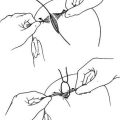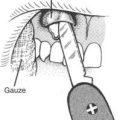WILDLAND FIRES
The wilderness adventurer or casual hiker in a forest or timbered park may find himself face to face with a wildland fire. This section will discuss high-risk situations, survival techniques, and medical considerations. Review the sections on burns (see page 108), lightning injuries (see page 395), heat illness (see page 322), and inhalation injuries (see page 114) as well.
HIGH-RISK SITUATIONS
1. There are drought conditions. Low humidity, higher air temperatures, and gusty winds create dry fuel for a fire.
2. You are in an area rich with abundant fuel, such as dead grass, pine needles, shrubs, fallen trees, and the like.
3. You travel through gullies, in canyons, along steep slopes, or in other regions where wind and fuel are ideal for rapid advance of an established fire.
4. Fires have occurred recently in the vicinity.
5. You cannot see the main fire and are not in contact with anyone who can.
STANDARD FIRE ENCOUNTER PRINCIPLES
1. Have advance knowledge of weather conditions and forecasts before undertaking an expedition. Do not travel in hazardous regions in times of high fire risk. Local ranger stations are the best source of information. Never plan an extended journey without leaving an itinerary with the proper authorities. In the event of a fire, try to maintain communication with firefighters or other rescuers.
2. At every campsite, take a few moments to prepare a plan for an evacuation, with at least two escape routes. Be certain that everyone understands the routes.
3. If a fire is in the area, pay attention to it, so that you will know what the fire is doing. Obtain current information on fire status. If there is any chance that it can involve your party, get out early.
4. If you see smoke or fire at a distance, post a lookout to watch for any changes that might indicate increased danger.
5. In all situations, stay calm and act with authority. Give orders concisely and be sure that they are understood. Base all of your actions on the current and expected behavior of the fire.
6. Do not attempt to fight the fire unless you have provided for safety first. Your first responsibility is to evacuate all potential victims and provide necessary first aid. In general, it is best to leave fire fighting to professionals. If you become a fire fighter, provide for safety first. Determine safety zones and escape routes.
7. Do not sleep near a wildland fire. If the wind and fire direction change, you may be overcome with smoke and unable to escape.
WHAT TO DO WHEN CAUGHT IN A WILDLAND FIRE
1. Try not to panic. This is difficult, but if anything will save your life, it will be a clear head.
2. Don’t move downhill toward a fire, because fires have a tendency to run uphill.
3. Unless the path of escape is clear, don’t start running. Conserve your strength, and seek the flank of the fire. Continually observe changes in speed and direction of the fire and smoke to choose travel away from fire hazards. Be alert, keep calm, and avoid injury from rolling or falling debris.
4. Enter a burned area, particularly one with little fuel (grass or low shrubs). Although there is a chance that the area might burn again, you are better off here than in an area of fresh fuel. If you have to cross the fire line, cover your skin as well as possible, take a couple of deep breaths, and dash through the lowest flames (less than 3 ft, or 92 cm, deep and where you can see through them). If smoke is dense, crawl along the ground for better air and visibility.
5. If you cannot enter a burned area, ignite grass or other fine fuels between you and the fire edge. After this area burns, step into it and cover your exposed skin with clothing or dirt. This is not an effective technique in areas of heavier fuels.
6. Try to avoid breathing smoke. Hold a moistened cloth over your mouth. If the air is very hot, use a dry cloth (dry heat is less damaging to the lungs than is steam). If you have a choice of clothing, cover your skin with closed-toe shoes, a long-sleeved cotton or wool shirt, cotton or wool pants, a hat, and gloves.
7. Seek refuge from the radiant heat. Take shelter in a trench, in a pond, behind rocks, or in a stream, vehicle, or building. Do not climb into elevated water tanks, wells, caves, or any other place where you might be trapped or quickly use up the available oxygen.
8. If all else fails and you cannot escape the advancing flames, lie face down on the ground and cover your exposed skin as best possible. This is better than standing or kneeling.
9. If you are near a vehicle, and there is no route for escape, it is better to stay in the vehicle than to run from the fire. Try to position the vehicle in an area of little natural vegetation. Avoid driving through dense smoke. Turn off the headlights and ignition. Roll up the windows, close the air vents, and shield yourself from the radiant heat by covering up with floor mats or hiding under the dash. Stay in the vehicle as long as possible (it is rare for a gasoline tank to explode, and it takes a minute or two for the vehicle to catch on fire). Do not be overly alarmed if the vehicle rocks, or if smoke and sparks enter the vehicle. When the fire passes, cover your nose and mouth with a moistened cloth to avoid inhaling fumes from burning plastics and paint. Use urine if no other liquid is available.
10. If you are in a building and a fire is approaching, attach hoses to external water fixtures to achieve as much water spray coverage as possible. Place lawn sprinklers on the roof or use the hoses to soak down the roof. Put a ladder outside that will reach the roof. Locate and position buckets, rakes, axes, and shovels. Soak down shrubs and combustible foliage within 20 ft (6 m) of the building. If you have time, also do the following:
CREATING A DEFENSIBLE SPACE
1. Use fire-resistant external construction materials, particularly for the roof, where embers may fall. Wooden shakes are highly flammable. Keep the gutters clean of combustible materials.
2. Remove combustible materials from close proximity to the dwelling. This includes piles of wood, flammable refuse, leaf litter, dead limbs, and piles of slash. Dry underbrush within stands of trees close to a dwelling serves as tinder for a fire.
3. If landscaping is flammable, maintain it as far as possible from the dwelling, so that it does not provide an easy flame path to your home. The further that combustible landscaping is located from the at-risk buildings, the better. A recommended minimum distance is 30 to 50 feet. In addition, create paths and openings that allow firefighters easy access to the dwelling.
4. Keep all trees and shrubs pruned of dead limbs and leaves. Do not allow large trees, dead or alive, to overhang your home. Maintain a green lawn if the lawn is adjacent to your home. Do not allow grass to grow tall and become dry, so that it can easily burn.
5. To block embers from entering your home, use metal screens over vents and other openings. Otherwise, they can enter and ignite the inside of the dwelling.
MEDICAL CONSIDERATIONS
The three most common medical problems in a wildland fire situation are burns (see page 108), smoke inhalation (see page 115), and dehydration (see page 207), followed by heat illness (see page 322) and poison ivy or oak exposure (see page 232). Anyone exposed to the constant and intense heat of a forest fire should consume at least a pint to a quart (½ to 1 liter) of fluid per hour.
CARBON MONOXIDE POISONING
In general, there is not a shortage of oxygen in the region of an outdoor fire, so long as there is adequate ventilation. However, in an enclosed space, oxygen may be rapidly depleted as toxic gases and smoke accumulate. This can occur when people cook inside a tent or snow cave, particularly with gasoline or kerosene as fuel. The most commonly inhaled toxin is carbon monoxide, which is the tasteless, odorless, and colorless product of incomplete combustion. Carbon monoxide binds to hemoglobin (the oxygen-carrying pigment in red blood cells) with 200 times the affinity of oxygen. Thus, a human victim suffers from markedly diminished delivery of oxygen to all organ systems. Symptoms of carbon monoxide intoxication include the following:
Mild (10% level measured in the blood). Decreased exercise tolerance, decreased ability to concentrate, headache, nausea.
Moderate (20% level). Severe headache, vomiting, poor coordination, decreased vision, decreased hearing, shortness of breath.
Severe (30% level). Confusion, lethargy.
Catastrophic (40% to 60% level). Fainting, unconsciousness, gasping respirations, seizures, shock, death.
If a person is suspected to have inhaled any toxic gas, he should be moved to fresh air as soon as possible, and have oxygen (see page 431) administered at a flow rate of 5 to 10 liters per minute by facemask. Anyone overcome with smoke inhalation should be rapidly transported to a hospital. Be prepared to manage the airway (see page 22). The definitive treatment for severe carbon monoxide poisoning is treatment with oxygen in a hyperbaric chamber. If a person suffers from carbon monoxide poisoning and is allowed to breathe normal air, it takes 4 to 5 hours for half of the carbon monoxide in his system to be eliminated. This elimination time (“half-life”) is decreased to 45 to 60 minutes if he breathes 100% oxygen through a facemask, however, and can be decreased to 15 to 20 minutes if oxygen is breathed under 3 atmospheres of pressure in a hyperbaric chamber.





